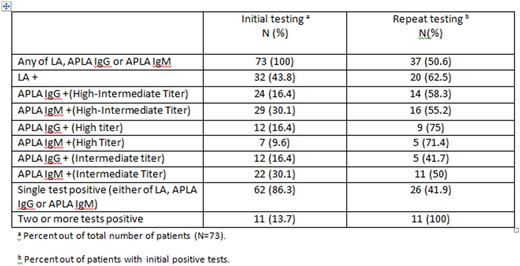Abstract

Background. Lupus Anticoagulants (LA) and Antiphospholipid Antibodies (APLA) are known to be associated with both arterial and venous thromboembolism (VTE). The implications of positive test results often include indefinite anticoagulant therapy and thus accurately identifying these patients is important. Current guidelines for laboratory testing of both LA and APLA, require that initial positive results are confirmed by repeat testing at least 12 weeks after initial positivity to be considered diagnostic. Repeat testing is not routinely performed once a patient is deemed to be positive. If repeat testing is performed years after initial confirmation and is negative, the clinical implications of this are not certain and there are no criteria to determine which patients can safely be considered negative. We aimed to determine the proportion of patients with positive LA or APLA who remained positive at least 2 years after initial confirmation.
Methods. We retrospectively reviewed a cohort of patients with positive LA and APLA evaluated at the Thrombosis Clinic of the London Health Sciences Centre (London, Ontario, Canada) between 1998 and 2016 and who had repeat LA/APLA tests done at least 2 years after the initial LA/APLA positive confirmation. LA testing was done as per the International Society on Thrombosis and Haemostasis criteria available at the time of testing, using dilute Russell viper venom time screening and confirmatory tests in all cases. APLA testing was done using commercial enzyme-linked immunosorbent assays (Louisville APL Diagnostics Inc. or Inova Diagnostics Inc.), according to the manufacturers' instructions.
Results. We included 73 patients (39 [53.4%] female). The average age at diagnosis of LA or APLA was 49.3 years. The average follow-up was 103.1 months (range 24 to 218 months). At diagnosis, 57 (78%) patients had a VTE (26 deep vein thrombosis [DVT], 16 pulmonary embolism [PE], 17 both DVT and PE), 10 had a stroke or transient ischemic attack (TIA) and 3 myocardial infarction (MI). Warfarin was the most common long-term anticoagulant used (66 of 73 patients). Nine patients were treated with rivaroxaban, 5 with LMWH, and 1 patient was treated with edoxaban. A total of 4 patients did not require anticoagulant therapy. Eleven (15.1%) patients suffered a recurrent thrombotic event while on anticoagulant therapy, (5 DVT, 5 PE, 1 DVT and PE). Nine of the recurrent events occurred while the patient was being treated with warfarin. Four of the 40 female patients suffered at least one miscarriage. One patient died while being followed due to complications from renal failure. The mean time between the first positive test and the first confirmatory test was 8.9 months (range 3 to 132), whereas the mean time between the first confirmatory test and the first repeat test was 68.9 months (range 24 to 207). Thirty-seven (50.6%) patients were negative on the second repeat test. All of them remained on anticoagulants.
Conclusion. Our results suggest that up to 50% of patients became negative for LA and/or APLA at least 2 years after initial positivity, particularly if only one type of test was positive at diagnosis. The clinical relevance of this result is not certain including implications about discontinuing anticoagulant therapy. Further research in this relevant matter is warranted.
Lazo-Langner:Pfizer: Honoraria; Bayer: Honoraria; Daiichi Sankyo: Research Funding. Louzada:Pfizer: Honoraria; Janssen: Consultancy, Honoraria; Celgene: Consultancy, Honoraria; Bayer: Honoraria. Kovacs:Daiichi Sankyo Pharma: Research Funding; LEO Pharma: Honoraria; Bayer: Honoraria, Research Funding; Pfizer: Honoraria, Research Funding.
Author notes
Asterisk with author names denotes non-ASH members.

This icon denotes a clinically relevant abstract


This feature is available to Subscribers Only
Sign In or Create an Account Close Modal